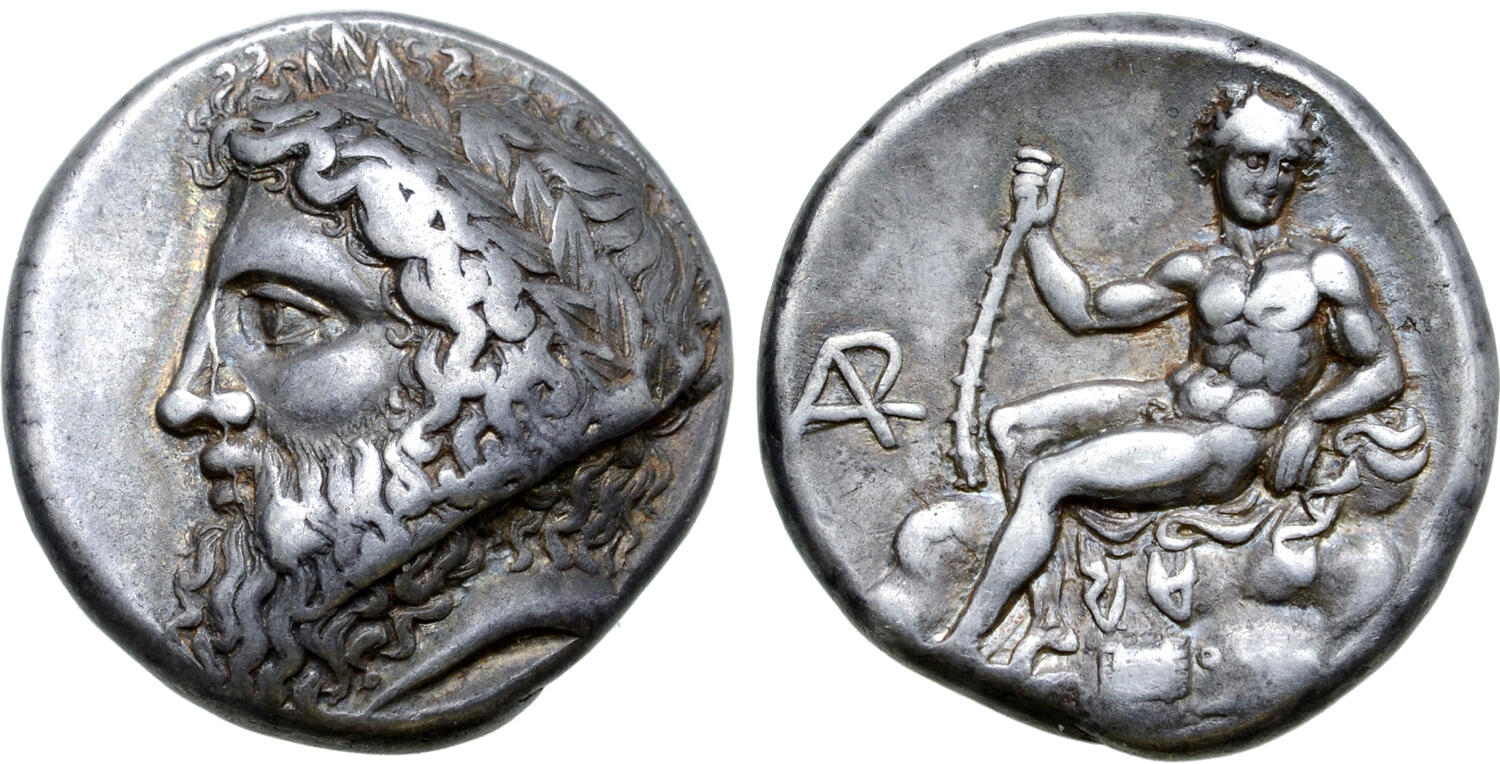Megalopolis? (Arcadian League), silver, staters (363-362 BCE)
From SILVER
363 BCE - 362 BCE Silver 733 kg
Description
| ObverseInscription or printing placed on the obverse.: | Bearded, laureate head of Zeus Lykaios to left. |
| ReverseInscription or printing placed on the reverse.: | OΛVM (Greek).Youthful Pan reclining upon a rocky outcrop, his head three-quarters facing, mantle spread beneath him, holding in his right hand a lagobolon (throwing club for the hunting of hares), syrinx propped against the rocks below on which are written OΛVM in small letters, monogram of the Arkadian League in left field. |
Mint and issuing power
| MintIdentifies the place of manufacture or issue of a numismatic object.: | Megalopolis | Ancient regionAncient region.: | Peloponnesus | Modern countryModern country: Greece | AuthorityIdentifies the issuing power. The authority can be "pretended" when the name or the portrait of X is on the coin but he/she was not the issuing power. It can also be "uncertain" when there is no mention of X on the coin but he/she was the issuing power according to the historical sources: | Arcadian league |
Chronology
| FromIdentifies the initial date in a range assigned in a numismatic context. | 363 BCE | toIdentifies the final date in a range assigned in a numismatic context.. | 362 BCE | PeriodTime period of the numismatic object.: Classical 480-323 BC |
Physical description
| MetalThe physical material (usually metal) from which an object is made.: | Silver |
Median weightMedian of the weights of numismatic objects (in grams). in grams | 12.10 | DenominationTerm indicating the value of a numismatic object. Examples: tetradrachm, chalkous, denarius.: | stater |
StandardStandard.: |
Image

AC203 Arkadia.jpeg [1]
References
| Die study referencePublication of the study: | Gerin 19861Gerin 1986, p. 13-31, pl. 2-5. | ||
| Coin series referenceReference to coin series study: | Sear I2Sear I, n° 2686, RQEMAC3RQEMAC, n° 203, HGC 54HGC 5, n° 928 | ||
| Coin series web referenceCoin series web references: | |||
Obverse dies distribution
| FrequencyFrequency of specimen in distribution. ᵖ | Number of obversesNumber of obverse dies. ᵖ (o) | % (o) | Number of coinsNumber of coins. (n) | % (n) | Die nameName(s) of the die(s). |
| 1 | 1 | 33.33 | 1 | 3.13 | 3 |
| 12 | 1 | 33.33 | 12 | 37.5 | 1 |
| 19 | 1 | 33.33 | 19 | 59.38 | 2 |
| Total | 3 of 3 | 99.99 | 32 of 32 | 100.01 |
Reverse dies distribution
no distribution is available
Quantification
| Number of obversesNumber of obverse dies. ᵖ (o) | 3 | Number of singletons (o1)The number of singleton coins. ᵖ | 1 |
| Number of reverse diesNumber of reverse dies. (r) | 6 | Number of coinsNumber of coins. (n) | 32 |
| Coins per obverse dieNumber of coins per obverse die. (n/o) | 10.67 | Coins per reverse dieNumber of coins per reverse die. (n/r) | 5.33 |
| Reverse per obverse ratioRatio of obverse dies divided by reverse dies. (r/o) | 2 | Percentage of singletons (o1)number of coins (n) divided by the number of singletons (o1) ᵖ | 33.33 % |
| Original number of dies (O) (Carter 1983 formula)The estimation of the number of coins according to Carter 1983 ᵖ | 3.03 | Coins struck if 20,000 as average productivity per dieCoins made if the average productivity for obverses (according to Carter) is 20,000. ᵖ | 60,600 |
| Original number of dies (O) (Esty 2011 formula)The estimation of the number of coins according to the singleton formula in Esty 2011 ᵖ (O) | 3.31 | Survival rate if 20,000 as average productivity per dieSurvival rate if average productivity is 20,000. ᵖ | 0.00053 |
| Coverage (o = % of O) (Esty 1984 formula)Esty 1984 - coverage (% of O) ᵖ (o = % of O) | 96.88% | Die productivity if survival rate 1/2,000Average productivity if survival rate is 1/2,000. ᵖ | 21,122.11 |
| Weight of silver (in kg) if 20,000 coins per die (O = Carter formula)Carter 1983 * Median weight * 20000 (*10 if gold or electrum) ᵖ | 733 kg <br /> 733 kg | Die productivity if survival rate 1/5,000Average productivity if survival rate is 1/5,000. ᵖ | 52,805.28 |
Remarks
Most likely one single workstation Certainly military